| FORUM8 Design Festival 2009-3Days |
| (Up&Coming 2010 New Year Special Issue) |
A Variety of Advanced Solutions for Civil Engineering and Construction
Design and Global Research on VR Gathered Together at the Festival
FORUM8 held "FORUM8 Design Festival 2009 - 3 Days" from November
18th to 20th, 2009 at Tokyo Conference Center Shinagawa. |
|
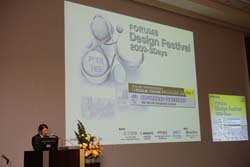 |
President Yuji Ito
|
The year of 2009 was a memorable year for us with "Engineer's Studio",
3 dimensional (3D) plate dynamic nonlinear analysis program which we had
been developing with emphasis for these years, released in February, and
"VR-Studio", a multifunctional VR system that supports large
scale projects, also released in October. We integrated "International
VR Symposium" and "3D VR Simulation Contest" that had been
held annually at this time of the year, and "Design Conference"
that had been held separately so far into "Design Festival" to
introduce these new solutions as well as our latest technologies and tendencies
of related research in and outside Japan on a larger scale.
One of the three events that comprise "Design Festival" is "Design
Conference". This is based on "UC-win/FRAME (3D) Conference"
that started in October 2003, following the release of UC-win/FRAME(3D),
3 Dimensional Analysis Program for Space-Framed Structures in 2002. Since
2007, the conference has been expanded into "Design Conference"
by holding it simultaneously with "UC-win/UC-1 User Conference",
and it is the 3rd time to have this form of conference this year.
Another event, "International VR Symposium", aims to discuss
and utilize excellent research, technologies, and ideas related to VR.
In 2007, "World 8", an international academic group for 3D VR
was organized with researchers in architecture and construction fields.
The Symposium was started as a place to publish the research products.
The number of participating researchers of the group was almost doubled
for the activities in 2009, when the symposium was to be held for the third
time. The group has been led by Dr. Yoshihiro Kobayashi, Ph.D., Arizona
State University Prism Lab. Research Faculty (FORUM8 AZ LLC. CEO &
President) from the beginning. It was reorganized as "World 16"
with Dr. Kobayashi as its core. At the symposium, each member gave a presentation
of the research outcome, reflecting even more various specialties than
before.
Still another event, "3D VR Simulation Contest" was established
when "UC-win/Road", a 3D real-time VR product won "Software
Product of the Year" prize in 2002.It is for the 8th time to hold
the contest, having more advanced and diversified entry products year by
year. Submissions come from not only inside Japan but also from abroad
in broader areas.
This year's Design Festival comprised 3 days: [Day1] included <Design/Analysis>,
<Architecture/BIM>, and <Water Engineering> sessions of "the
3rd Design Conference"; [Day 2] included the rest <CAD & VR>,
<Technical Support>, session of the Conference and "the 3rd
International VR Symposium"; and [Day 3] included "the 8th 3D
VR Simulation Contest". Especially in consideration of welcoming many
speakers and users from abroad, we integrated these related events as well
as prepared simultaneous interpretation for 4 languages of Japanese / English
/ Chinese / Korean at the main hall. In addition, regarding the presentations
given at the main hall, we provided TV conference system to connect with
the sites at Osaka, Nagoya, Fukuoka, Beijing, and Shanghai for the participants
there.
We report the Design Festival in a two-part serial: this issue (Vol. 83:
Day 1 & 2) and the next issue (Vol. 84: Day 2)
|
| [Day1] The 3rd Design Conference |
At the 1st day of the 3-day Design Festival, the 3rd Design Conference
opened with the sponsor's address by Yuji Ito, President of FORUM8.
The 1st speaker was Prof. Koichi Maekawa, Professor, Graduate School of
Engineering, University of Tokyo. He gave a special lecture entitled "Nonlinear
Analysis of Deteriorated RC Structure and Method of Structurizing Knowledge".
He explained on the latest information about multi-scale and multi-phase
physiochemical coupled analysis, modeling of deteriorated structure and
response analysis, high cycle fatigue loading and life estimation by direct
integration method, and response analysis and life of composite deck slab
for a highway bridge.
Then from 1:00 pm, the conference was divided into <Design/Analysis>
session of the Main Stream and technical sessions of <Architecture/BIM>,
and <Water Engineering>, which continued over 4 hours.
|
|
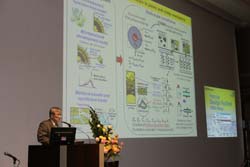
 Professor Koichi Maekawa, Graduate School of Engineering, University of
Tokyo Professor Koichi Maekawa, Graduate School of Engineering, University of
Tokyo |
| Design/Analysis Session (Stream-1) |
Our staff made the first presentation of this session, entitled "Engineer's
Studio(TM) and its Future Development". He presented on the product
overview of Engineer's Studio(TM) and UC-win/FRAME(3D), their new functions,
and the future development plan. He also explained some features under
development, showing their operation procedures.
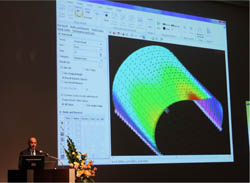
 FORUM8 Brent Fleming FORUM8 Brent Fleming |
Then, Mr. Hiroki Aoto, Researcher at Tokyo City University gave a special
lecture entitled "Analysis Cases with FRAME3D and Challenges of Engineer's
Studio". Taking steel arch bridge as an example, he explained the
difference of initial stress conditions of arch lib that was confirmed
using UC-win/FRAME(3D), or the effect of slab deck stiffness on the result
of dynamic analysis. He also gave advice based on them, and mentioned his
request towards the future development of Engineer's Studio as well as
his evaluation and points to note as a user.
>> See report on special lecture2

 Mr. Hiroki Aoto, Tokyo City University Mr. Hiroki Aoto, Tokyo City University |
Then, our staff made a presentation entitled "Analysis Cases with
FRAME3D and Analysis Competition Report". His explanation included
transition of UC-win/FRAME(3D) Analysis Support Service, Revision of aseismic
Construction Method for Waterworks Guideline and Commentary, and a modeling
method of the analysis model used at the analysis contest for a large bridge
aseismic experiment conducted in National Research Institute for Earth
Science and Disaster Prevention with its analysis results.
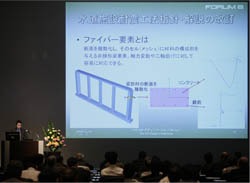
 Yoshitaka Kai, FORUM8 Yoshitaka Kai, FORUM8 |
In the latter part of the session, Prof. Keizo Ugai, Professor of School
of Engineering, Gunma University, gave a special lecture entitled "Present
Situation of Ground Analysis and Future Development". He explained
on evaluation of safety factor of slope with elasto-plastic FEM, a method
of estimating and deciding countermeasures with FEM for ground liquefaction,
solution of mechanism of large-scale landslide caused by a great earthquake
with dynamic elasto-plastic FEM. He emphasized the effectiveness of FEM
applied in these situations.
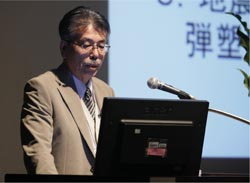
 Professor Keizo Ugai, Gunma University Professor Keizo Ugai, Gunma University |
Following this, Mr. Toshihiro Hanada, President of Bulld Geotechno Co.,Ltd.
gave a special lecture entitled "Customer's Case of Ground Analysis:
Overview and Challenges of Design". He presented analysis cases using
GeoFEAS in issues such as the whole stability problem of land prepared
for housing development including cliffs, problems of ground deformation
in reservoir refurbishment, and quake resistance testing of a built retaining
wall.
>> See report on special lecture4
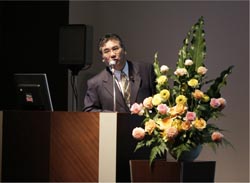
 Mr. Toshihiro Hanada, Bulld Geotechno Mr. Toshihiro Hanada, Bulld Geotechno |
Finally, our staff made a presentation entitled "the Latest Functions
of Ground Analysis Series and 'Slope Stability Analysis' Supporting New
Earthwork Guideline". He described linkage of Ground Analysis Series
such as GeoFEAS and VGFlow with UC-1 Design Calculation, points in revision
of earthwork guidelines, and how they are supported by Slope Stability
Analysis Ver.8.

 Atsushi Nakamura, FORUM8 Atsushi Nakamura, FORUM8 |
| Architecture/BIM Session (Stream-2) |
This session started with a special lecture given by Mr. Ryota Ieiri, Ieiri
Laboratory, Nikkei BP, entitled "Beyond World Class! Advancing BIM
in Japan with Japanese Spirit and Western Learning".
He mentioned positioning of BIM in JAPAN that is seen through Build Live
Tokyo, overview of BIM and example applications in foreign countries, and
innovation using BIM, describing his expectation towards its spread.

 Mr. Ryota Ieiri, Ieiri Laboratory, NikkeiBP Mr. Ryota Ieiri, Ieiri Laboratory, NikkeiBP |
The subsequent lecture comprised two parts. The first part, entitled "Allplan
(Architecture) Japanese Version", was given by Mr. Sven Elbl, Director
of Product Management of Nemetschek Allplan Gmbh. He talked about the overview
of the NEMETSCHEK and Allplan software suite products, the company's view
about BIM, and the functions of Allplan in there. The second part, entitled
"Application cases of Allplan to Architecture in Korea", given
by Mr. Kim Gibom, Basissoft Inc. Taking BIM-applied projects using Allplan
as examples, he introduced various functions and advantages of Allplan.
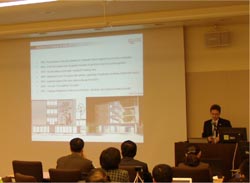
 Mr. Sven Elbl, Nemetchek Mr. Sven Elbl, Nemetchek |
|
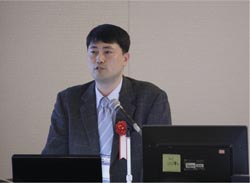
 Mr. Kim Gibom, Basissoft Mr. Kim Gibom, Basissoft |
Following this, our staff made a presentation entitled "BIM Solution
at Build Live Tokyo 2009 II". He reviewed how we worked on the competition
sponsored by IAI Japan "Build Live Tokyo 2009 II", BIM solutions
applied there through analysis and simulation using FORUM8 tools including
Allplan, and award winning of Engineering Award.
The latter half of the session was started by a special lecture by Mr.
Jake Hannah, Formation Design Systems, Australia, entitled "Multiframe
Ver. 12 supporting plate element". Firstly, he introduced the features
of Multiframe software and its related products and so on. Based on this,
he talked about its application examples to plate models and other flat
items, focusing on plate element analysis that is the greatest feature
of Multiframe Ver. 12.

 Mr. Jake HannahFormation Design Systems Mr. Jake HannahFormation Design Systems |
Our staff made the following presentations. "Energy Analysis Design
Builder Ver. 2" showed the procedure to simulate thermal environment
or CO2 emissions of a building by linking Design Builder that performs
architecture simulation and EnergyPlus that performs architecture energy
simulation. The speaker mentioned possibilities brought about by linkage
between Design Builder and other FORUM8 products.
Next presentation, "Example Cases and Proposal of Exodus: Fire Evacuation
Analysis" introduced features and functions of EXODUS that performs
evacuation simulation and SMARTFIRE that performs fire simulation, as well
as application cases of EXODUS to examination of evacuation from a housing
complex, fire drill for a high-rise building, and examination of evacuation
from tunnel-vehicle fire.
In addition, "Analysis Functions provided by UC-win/Road: Noise &
Wind Analysis and Lighting simulation" showed the features of the
noise analysis function that is a new optional function of UC-win/Road,
concept of sound propagation, procedures from pre-processing to input,
analytical calculation, output, and post-processing. The presenter also
mentioned development situation of wind analysis function and simulation
of lighting calculation.
| Water Engineering Session (Stream-3) |
This session was jointly held with xpswmm Customer Meeting, which is organized
by SWMM User Group and supported by NPO Water Environment Construction
Club, FORUM8 and XP Software with a topic of "Flood Seminar: Latest
Information on anti-inundation measure and run off analysis model.
Professor Yoshihisa Kawahara, Graduate School of Engineering, Hiroshima
University made opening remarks of the session. He then gave a special
lecture entitled "Challenge for Using Flood Analysis Technology for
Multiple Purposes". He discussed analysis method of combining aero
laser survey data with non-structural grids, modeling building-fluid interaction
and phenomenon smaller than a calculation grid, and a method of estimating
flood discharge from a river.
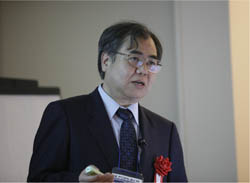
 Professor Yosihisa Kawahara, Hiroshima University Professor Yosihisa Kawahara, Hiroshima University |
Next, Mr. Takateru Ishikawa, Water Environment Construction Club (NPO),
gave a special lecture entitled "Utilization of Runoff Analysis Model
in Response to Climate Change in the Future". He talked about how
the runoff analysis model came into wide use, change of precipitation caused
by climate change, conversion into an effective design method, analysis
cases using 1D and 1D/2D models, hazard maps for inland waters, how to
use runoff analysis model in the future and the functions to be expected.
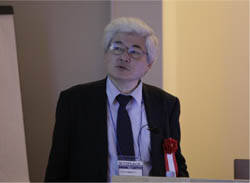
 Mr. Ishikawa Takateru Mr. Ishikawa Takateru |
It was followed by a special lecture given by Professor Masaru Morita,
College of Engineering, Shibaura Institute of Technology, entitled "Quantification
of Flood Risk of Urban Rain Water Drainage and Application to Flood Risk
Management". He discussed what is flood risk management, a predictive
model for inundation damage, approach to flood risk assessment, and application
to flood risk assessment.
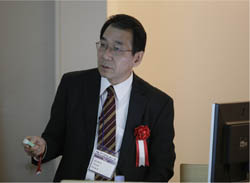
 Professor Masaru Morita, Shibaura Institute of Technology Professor Masaru Morita, Shibaura Institute of Technology |
The latter half of the session started with special lectures by 3 speakers
in a relay form. First, Mr. Tatsuo Yamada, Nihon Suikou Sekkei Co.,Ltd.
gave a lecture entitled "About CommnMP: Common Platform of Water and
Material Circulation Analysis". He presented on the aims of developing
CommonMP promoted by Ministry of Land, Infrastructure and Transport and
its feature, the policy of developing and operating it, establishment of
the consortium based on the policy, advantages of developing it, present
situations of development, and a road map.
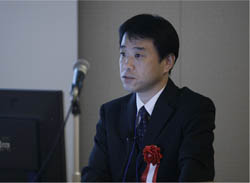
 Mr. Tatsuo Yamada, Nihon Suikou Sekkei Mr. Tatsuo Yamada, Nihon Suikou Sekkei |
Then, Mr. Shigenori Kawasaki, also Nihon Suikou Sekkei Co., Ltd. gave a
lecture entitled "Measures to Mitigate Flood Risk Using Ground Surface
Runoff Analysis". He showed a concept of mitigating risk through anti-inundation
measure with residential zones in flood-prone areas as key zones.
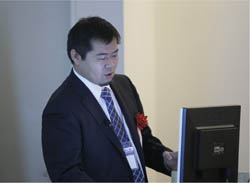
 Mr. Shigenori Kawasaki, Nihon Suikou Sekkei Mr. Shigenori Kawasaki, Nihon Suikou Sekkei |
Next, Mr. Kiyotaka Naganawa, Nakanihon Engineering Consultants made a presentation
entitled "Integrated Analysis of Rivers and Water Channel Networks
in an Area using xpswmm". Taking hydraulic analysis of a class B river
having a tunnel part and channel network in a low-lying area having river
water flooding as examples, he discussed investigation into flooding mechanism
and anti-inundation measure.
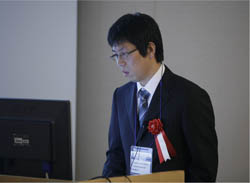
 Mr. Kiyotaka Naganawa, Nakanihon Engineering Consultants Mr. Kiyotaka Naganawa, Nakanihon Engineering Consultants |
Following this, Mr. Ashis Dey, XP-Software Pty Ltd, Australia made a presentation
entitled "Lecture by the Developer: Modeling of Overland Flooding
in Urban Areas - A 1D/2D Integrated Modeling Case Study". After explaining
the basics of hydrology and hydraulics as well as the functions and potential
of xpswmm in them, he introduced analysis cases of 1D/2D-integrated modeling.
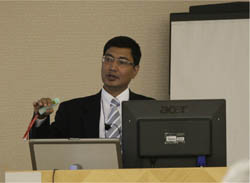
 Mr. Ashis Dey, XP-software Pty Ltd. Mr. Ashis Dey, XP-software Pty Ltd. |
The final presentation of the session was made by our staff, entitled "3
Dimensional VR of Flood Analysis: Collaborative Functions for xpswmm Provided
by UC-win/Road and Development of Water Engineering Design Series".
He explained the functions and examples of UC-win/Road for xpswmm plug-ins,
development schedule of software for UC-1 series water and sewage/river
design, and the overview of the revision of the guideline for aseismic
construction method for waterworks and its explanation.
| Report of Design Festival Customers Specail Lecture |
 Special Lecture 2 FRAME3D Analysis Case and Engineer's Studio(TM)'s Challenge Special Lecture 2 FRAME3D Analysis Case and Engineer's Studio(TM)'s Challenge
Mr. Hiroki Aoto Researcher, Tokyo City University
Mr. Hiroki Aoto Researcher, Tokyo City University gave Special Lecture,
titled"FRAME3D Analysis Case and Engineer's Studio(TM)'s Challenge"
on November 18th, the 1st day of the festival.
Mr. Aoto presented the anlysis result of 2 cases by using UC-win/FRAME(3D).
Regarding the metal arch bridge, 1.Influence of the difference of initial
stress conditions and 2. Influence of floor slab rigidity to the dynamic
analysisi result. Mr. Aoto has proposed the future developmnet of Engineer's Studio(TM), with the comparison with existing products.
Like UC-win/WCOMD, Engineer's Studio(TM) supports reinforced concrete guideline.
Engineer's Studio(TM) is applicable to large scale deformation analysis
and has improved user interface compared with UC-win/WCOMD. Engineer's
Studio(TM) has merits to UC-win/WCOMD customer.
Mr. Aoto suggested the introduction of ground element enables Engineer's
Studio(TM) to perform coupling analysis of FEM and FRAME. It will allow
customers to use it for many different purposes.
Mr. Aoto suggeted the development of non-linear analysis version. Mr. Aoto
stressed that the analysis program can be used not only by civil engineers,
but also by architects and construction engineers.FORUM8 will continue
to improve Engineer's Studio(TM) with the partnership with Mr. Aoto.
 Special Lecture 4 "Ground Analysis Customer Case:Design Overview and
Challenge" Special Lecture 4 "Ground Analysis Customer Case:Design Overview and
Challenge"
Mr. Toshihiro Hanada President, Bulld Geotechno
Mr. Toshihiro Hanada President, Bulld Geotechno gave a special lecture,
titled "Ground Analysis Customer Case:Design Overview and Challenge.
Mr. Hanada introduced the application of FEM analysis to design work by
showing 3 sample cases of GeoFEAS 2D. He also suggested themes and difficluties of ground analysis from the
business point of view.
The 1st case was developed land including cliff for housing complex.
The 2nd case was deformation of land at the time of repair of pond.
The 3rd case was earthquake resistance check of existing retaining walls
Mr. Hanada says that for customers, the major issues are the fact that
"results depend on modeling", "the time constraint"
and "the endless needs for accuracy". He says different result
comes from the changed range of analysis and that check and verification
sometimes requires 500-1000 analysis cases. He stresses that analysis is
always time consuming and requires customers experience.
Mr. Hanada gave us a comment saying GeoFEAS is superior in accuracy of
calculation and that papers by Gunma University researchers and our trainig
for CPD are helpful. We will continue trying to meet customers needs.
|
|
| [Day2] 3rd Design Conference / 3rd International VR Symposium |
| (Up&Coming 2010 Early spring issue) |
Day 2 Comprised the Latter Part of Design Conference and the International
VR Symposium
FORUM8 held "FORUM8 Design Festival 2009 - 3 Days" from November
18th to 20th, 2009 at Tokyo Conference Center Shinagawa. We integrated
"Design Conference", "the International VR Symposium",
and "3D VR Simulation Contest" which had been held separately
in two events before, into a festival with a new concept. |
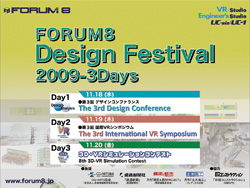 |
In 2009, we released "Engineer's Studio", 3 dimensional (3D)
plate dynamic nonlinear analysis program, and "VR-Studio", VR
system that supports large-scale and multifunctional projects, both of
which we had been developing as new flagship products of each series. As
the year of 2009 was a memorable year for us, we decided to introduce these
new solutions as well as our latest technologies and the related research
movements in and outside Japan on a larger scale.
As the first attempt, this year's Design Festival comprised 3 days: [Day1]
included <Design/Analysis>, <Architecture/BIM>, and <Water
Engineering> sessions of "the 3rd Design Conference"; [Day
2] included the rest the sessions of the Conference <CAD & VR>
and <Technical Support>, and "the 3rd International VR Symposium";
and [Day 3] included "the 8th 3D VR Simulation Contest".
We report the Design Festival in a serial; the previous issue (Vol. 83)
reported Day 1 & 3, and this issue (Vol. 84) focuses on Day 2. |
| [Day2] The 3rd Design Conference |
For the latter part of the 3rd Design Conference on the 2nd day of the
3-day Design Festival, Main Hall was divided into two rooms, one of which
was used for <CAD & VR> session. <Technical Support> session
was held at the same time in still another room, where the development
staff and engineers of FORUM8 were stationed all the time. They responded
to various questions and demands from the users of UC-1/UC-win products
and our solutions.
This session was opened up by Mr. Junichi Yamashita, Vice Chair, IAI Japan
Chapter. He delivered Special Lecture entitled "Build Live Tokyo 2009,
a Live Building Design Competition, and Innovation of Design and Production
Process". He talked about IAI's international efforts to promote standardization
of 3D building models for the purpose of mutual operation through data
sharing. He also presented as a part of this "Build Live Tokyo 2009"
that published the situation of participating teams to implement BIM (building
information modeling) while collaborating on the Internet in real time.
Then he explained the context of why BIM was required, the influences that
BIM has on building design and production processes and so on.
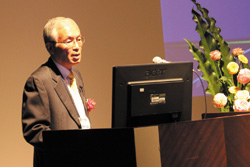
 Mr. Junichi Yamashita, Vice Chair, IAI Japan Chapter Mr. Junichi Yamashita, Vice Chair, IAI Japan Chapter |
The next special lecture comprised two parts. The first part, "Announcement
of Allplan (Engineering) Japanese Version", was delivered by Mr. Sven
Elbl, Director of Product Management, Nemetschek Allplan Gmbh (Germany).
After introducing the overview of Nemetschek company and its Allplan family
products, he explained improvement in productivity by 3D reinforcement
based on BIM with case studies. The latter part the lecture was entitled
"Case Study of Allplan in Civil Engineering Field in Korea" given
by Mr. Chris Kim, Senior Manager of Basissoft Inc., Korea, discussing what
is BIM, Allplan as BIM software, and its advantages and examples.

 Mr. Sven Elbl, Nemetschek Allplan Gmbh, Germany Mr. Sven Elbl, Nemetschek Allplan Gmbh, Germany |
|
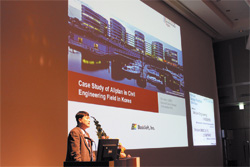
 Mr. Chris Kim, Basissoft Inc., Korea Mr. Chris Kim, Basissoft Inc., Korea |
The last special lecture in the morning was "Integrated Construction
Process by Graitec from Modeling to Design" by Mr. Alexandre Tartas,
COO, Graitec France. With an eye on various issues in the 21st century
including environment and energy, he talked about responses that the construction
industry is required to give, different BIM solutions offered by Graitec
in relation to them, and specific approaches to improving productivity
through one of these solutions, Advance Steel.
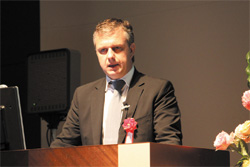
 Mr. Alexandre Tartas, COO, Graitec France Mr. Alexandre Tartas, COO, Graitec France |
The first presentation of the latter part of the session was made in two
parts, each by our staff. Entitled "VR-Studio(TM)", "UC-win/Road
Ver.4", the staff made a presentation of the latest information about
UC-win/Road. He explained the main features and basic functions of VR-studio,
its functions under development, new functions of UC-win/Road Ver.4 and
its functions under development. The second part, entitled "The Latest
Cases of VR System Development and Our Proposal", introduced examples
of setting up the 3D stereo view system, MR (mixed reality) / AR (augmented
reality) system, different drive simulators (DS), and their application
systems.
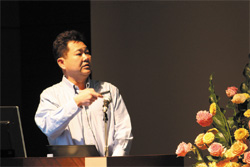
 Prof. Shigenori Tanaka, Faculty of Informatics, Kansai University Prof. Shigenori Tanaka, Faculty of Informatics, Kansai University |
Then, Prof. Shigenori Tanaka, Faculty of Informatics, Kansai University
gave Special Lecture "Development of Made-in-Japan 3 Dimensional CAD
Engine". He mentioned about "SXF", standard foundation for
2-dimensional CAD data exchange and said that specifications for SXF is
fixed and that some software programs that support it have been provided
so far. He further focused on the present situation that there is no low-cost
general-purpose 3 dimensional CAD offered in the field of construction
leading to little progress in use. He then described the idea of developing
"Made-in-Japan 3 Dimensional CAD Engine designed for the construction
field", and its core project named "Kansai University Kaiser
Project" the entire overview of the 3-D CAD Engine, and its future
vision.
Next, our staff made a presentation entitled "Introducing Pier Design
Ver. 7.0.1, which supports 3D Bar Arrangement simulation". He explained
its new function of making a visual inspection of bar arrangement in a
3D space with ease in comparison with the conventional method using only
2D drawings. Then he demonstrated the function using the new version of
"UC-1 Pier Design" that implements the function first.
After the break, our staff made a presentation "Survey and Civil Engineering
CAD, 12d Model and Link with UC-win/Road". First, he talked about
the basic functions and future development of the integrated software of
survey and civil engineering "12d Model". Then he introduced
how to use it and concrete cases, its link with UC-win/Road, as well as
its development status while showing demonstration.
Furthermore, another stuff of us made a presentation entitled "Development
of Verification System for Civil-Engineering Structural Design". He
explained the background and conditions of developing the system, which
was adopted for 2009 "Project for Promoting Innovation (Subsidy Program
for Developing Practical Industrial Technologies) "of New Energy and
Industrial Technology Development Organization (NEDO), then outlined the
concept, functions, features, and makeup of the system and the developing
procedure of the system. Then he mentioned individual systems (A, B, C,
and D) that compose the entire system, referring to the overviews of the
system A and B that are the targets for the time being and the images of
system C and D that are planned to be developed after that.
The last special lecture of the session was "Education for Engineers
/ The Role and Utilization of Software in University Education - Structural
Analysis is Such an Exciting Technology!" by Prof. Hiromichi Yoshikawa,
Advanced Research Laboratories of Tokyo City University. He first explained
the drastic advancement of commercial software products in structural analysis
or aseismic design. He continued that he was looking for structural engineers
to make further progress through utilizing them. Based on this, he showed
various cases of analysis with UC-win/FRAME (3D), explaining the points.
He also introduced the procedure of an exercise in three steps that he
devised after attempting to use a commercial software product (UC-win/Section)
and a mobile tool for civil engineering calculation (Mobile UC-1) at the
same time.
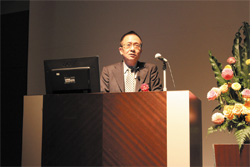
 Prof. Hiromichi Yoshikawa, Advanced Research Laboratories of Tokyo City
University Prof. Hiromichi Yoshikawa, Advanced Research Laboratories of Tokyo City
University |
|
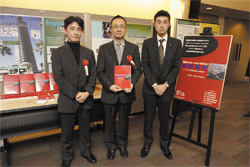 |
|
| [Day2] The 3rd International VR Symposium "New Age VR Simulation" |
VR-related Technologies Progressing in Architecture and Construction Fields
in the World: The Latest Research that Draws Attention by the International
Academic Group that Expanded in the 2nd Term
Another event of "FORUM8 Design Festival 2009-3days" day 2 (November
19, 2009), "the 3rd International VR Symposium" was held in the
room next to Design Conference in the Large Hall, Tokyo Conference Center
Shinagawa.
FORUM8 released the large-scale multi-VR "VR-Studio" in October
2009 as a new strategic VR product, and the latest version of the conventional
product "UC-win/Road Ver.4" in December. This symposium linked
the meantime, showing emerging directions and possibilities in wide-ranging
areas related mainly to building and construction as well as to urban development,
transport, and energy. |
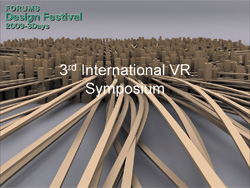 |
Proposed by Dr. Yoshihiro Kobayashi, currently Research Associate at Prism
Lab, School of Computing, Informatics, and Decision Systems Engineering,
Arizona State University, who has also been serving as Representative for
FORUM8 AZ since early 2009, FORUM8 organized "World 8" as a framework
for global collaboration among researchers in the field of architecture
and construction related to 3D VR modeling in 2007. In November that year,
the first International VR symposium was held in the form of declaring
its activities widely. Then related events had been held including "VR
workshop at ASU" (August in 2008) with the core members from "World
8", and "The 2nd International VR Symposium" (November 2008)
for summarizing and presenting the results of World 8's activities for
one year.
In 2009, partly because release of the above-mentioned "VR-Studio"
was expected, the international academic group was doubled in scale and
reorganized as "World 16". It was succeeded to a new project.
In May in the same year, the overview of "World 16" and some
of the new members were introduced at the "10th UC-win/Road Conference
and the Inaugural VR-Studio Conference". Then after holding "Summer
Workshop in Japan" (in September), it has been led to this International
VR Symposium, where its research products were presented. |
| VR Use in the Fields of Transport and Energy in Europe, and the Latest
Research Movement of "World 16" |
In the morning part of the "3rd International VR Symposium",
Mr. Pete Sykes, Director of Development, SIAS Limited, U.K., and Prof.
Nashwan Dawood, Director, Center for Construction, Innovation & Research
(CCIR), School of Science & Technology, University of Teesside, U.K.
delivered special lectures. Subsequently in the afternoon, members of "World
16" made research presentations, and FORUM8 Europe staff made a presentation.
Finally, Announcement of Academy Encouragement Prize was held for the World
16 members.
The speaker of the first special lecture of the symposium, "Application
and Case Study of Traffic Micro Simulation" was Mr. Pete Sykes, Director
of Development, SIAS, based in Edinburgh, Scotland, U.K. As SIAS provides
consultancy in traffic planning and urban issues as well as development,
sales, and support of microsimulation software (S-Paramics Microsimulation),
he talked about traffic planning software and innovation of tools with
focus on the difference between the conventional approach and microsimulation.
Next, he mentioned several project cases actually using microsimulation
and gave detailed explanation about them respectively. He further focused
on each function of animation and simulation by microsimulation, discussing
the idea that they are essential for performing traffic evaluation while
considering various elements in line with the current circumstances.
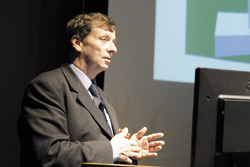
 Mr. Pete Sykes, SIAS Limited Mr. Pete Sykes, SIAS Limited |
|
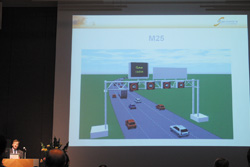
|
Prof. Nashwan Dawood, Director, CCIR, School of Science & Technology,
University of Teesside, U.K. gave a lecture entitled "Simulation and
Optimization Technology 4EE Building". As a specific case of simulation
and optimization technologies towards realization of energy-efficient buildings,
he presented an EU funded project, "IntUBE", that explores intelligent
use of energy information related to buildings, with his own activities
in it. He first talked about EU's plan to improve energy efficiency as
the background, and moved to the overview and outline of IntUBE aiming
to develop solutions towards EU's goal of 20% reduction of energy consumption
by 2020. He then explained the business model to be required and related
tools, as well as the developed products so far and the future efforts.
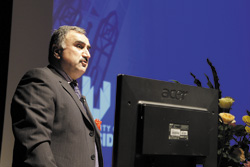 |
|
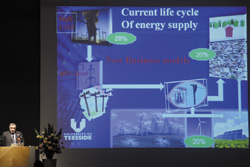 |
 Prof. Nashwan Dawood, University of Teesside, U.K. Prof. Nashwan Dawood, University of Teesside, U.K. |
| Presentations by "World 16" |
Dr. Yoshihiro Kobayashi, who has been leading the activities of World 8
from its start as a representative, chaired the presentations of "World
16" in the afternoon.
Prof. Tomohiro Fukuda, Associate Professor of Environmental Design &
Information Technology, Division of Sustainable Energy & Environmental
Engineering, Graduate School of Engineering, Osaka University made the
first presentation of "World 16", entitled "Development
of a City Presentation Method by Linking a Viewpoint Between Physical Model
and VR". He developed a mechanism of linking a 1/300 scale physical
model of Nakanoshima with VR model, Osaka, pointing the physical model
with a laser pointer, having a sensor to read it and displaying in VR.
He introduced the system of connecting advantages of a physical model and
VR while demonstrating the prototype.
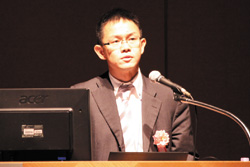 |
|
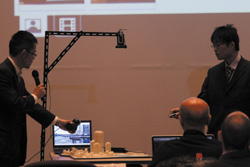 |
 Associate Prof. Tomohiro Fukuda, Environmental Design & Information
Technology, Graduate School of Engineering, Osaka University Associate Prof. Tomohiro Fukuda, Environmental Design & Information
Technology, Graduate School of Engineering, Osaka University |
A group project by several researchers in Taiwan, "Next-GENE of Virtual
World" was presented by Prof. Sheng-Cheng Shih, Assistant Professor,
Department of Digital Design, MingDao University on behalf of the group.
In the project of designing houses with more than 20 architects in and
out of Taiwan participating, they created simulation of villages and traffic,
and representation of buildings, in VR environment built up with UC-win/Road
for proposing a house design imitating calligraphy. He said that the effectiveness
of VR was accepted.
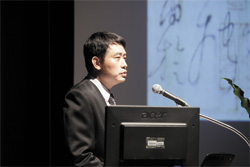 |
|
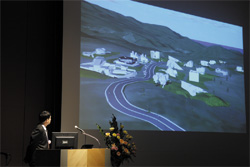 |
 Assistant Prof. Sheng-Cheng Shin, Department of Digital Design, MingDao
University Assistant Prof. Sheng-Cheng Shin, Department of Digital Design, MingDao
University |
Prof. Michael Jemtrud, Associate Professor of Architecture, Director, School
of Architecture, McGill University made a presentation "VR Model of
Repair Improvement of Turcotte Highway Interchange". He used UC-win/Road
for creating a platform to build consensus among state and city governments
and stakeholders across various areas in rehabilitating an important interchange
in Montreal. Setting up three scales for the city scale, view from the
road, and neighborhood / human scales, he introduced animation as a product
of visualization by inputting all the required information. He also mentioned
the next step.
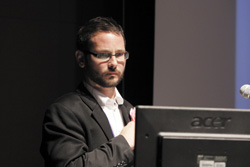 |
|
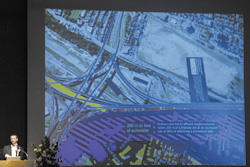 |
 Associate Prof. Michael Jemtrud, Director, School of Architecture, McGill
University Associate Prof. Michael Jemtrud, Director, School of Architecture, McGill
University |
Research Scientist Matthew Swarts, College of Architecture, Georgia Institute
of Technology, made a presentation of a group project by several researchers
in the U.S. "Noise Analysis and Combined Form of Highway Bridge in
Orlando" on behalf of the group. This is a research project with focus
on redevelopment of the Bridge District along I-4 in the downtown of Orlando.
He talked about the process of creating 3D models based on various pieces
of information about the site collected by the group researchers and their
students, importing them into UC-win/Road, and performing different traffic
simulations. He also mentioned their efforts such as visualizing noises
through the products.
 |
|
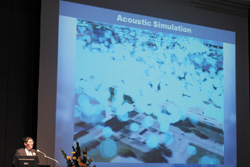 |
 Research Scientist Matthew Swarts, College of Architecture, Georgia Institute
of Technology Research Scientist Matthew Swarts, College of Architecture, Georgia Institute
of Technology |
Next presentation was also made for a group project "VR Model of Reproduction
of Historic Streets in 18th Century in UAE". First, Prof. Ronald Hawker,
Associate Professor, Department of Art & Design, College of Arts &
Sciences, Dubai Campus, Zayed University, UAE introduced their activities
for the historical areas in the north-east part of UAE including Ras al-Khaimah,
e.g. creating 3D models from pieces of information on the areas with UC-win/Road
and applying them to various research. Then Prof. Thomas Tucker, Assistant
Professor, Department of Fine Arts, Winston Salem State University in the
U.S. explained the process of creating models from a technological aspect.
In addition, a student who performed actual operation talked in the video
about more detailed technique.
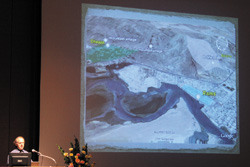 |
|
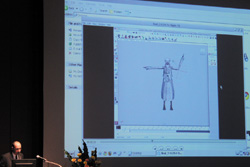 |
 Associate Prof. Ronald Hawker, Department of Art & Design, College
of Arts & Sciences, Dubai Campus, Zayed University Associate Prof. Ronald Hawker, Department of Art & Design, College
of Arts & Sciences, Dubai Campus, Zayed University |
|
 Assistant Prof. Thomas Tucker, Department of Fine Arts, Winston Salem State
University Assistant Prof. Thomas Tucker, Department of Fine Arts, Winston Salem State
University |
Speakers from Graduate School of Harvard University made next presentations.
First, Mr. Taro Narahara, Doctor of Design Student, Graduate School of
Design, Harvard University spoke under the title of "Development of
Linking System for VR and Interactive Devices" While he reviewed his
work including visualization of human behavior models, he mentioned a project
in which he introduced actions captured from real people into motions of
figures, and represented more realistic figures on UC-win/Road. This time,
he explained the mechanism that enabled real-time interaction by linking
simulation and UC-win/Road on a real time basis through joint development
of plug-ins with FORUM8. He showed his expectation towards a new possibility
that the mechanism would bring about.
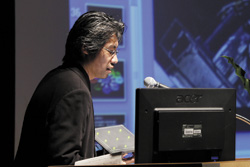 |
|
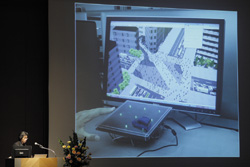 |
 Mr. Taro Narahara, Doctor of Design Student, Graduate School of Design,
Harvard University Mr. Taro Narahara, Doctor of Design Student, Graduate School of Design,
Harvard University |
Then Prof. Kostas Terzidis, Associate Professor of Architecture, Graduate
School of Design, Harvard Univ. discussed the design approach of obtaining
a final solution through repeating random search. In the mean time, various
solutions are applied to UC-win/Road, making evaluation while exploring
potentials, and choosing the best one. For optimizing, he explained a procedure
of stratifying problems, performing parallel processing, and displaying
them with UC-win/Road, using examples of simplified shapes, houses, and
a road network.
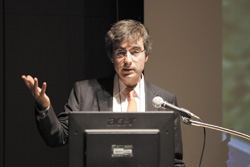 |
|
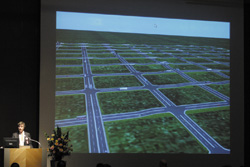 |
 Associate Prof. Kostas Terzidis, Graduate School of Design, Harvard University Associate Prof. Kostas Terzidis, Graduate School of Design, Harvard University |
The first speaker after the break was Prof. Paolo Fiamma, Assistant Professor
of Technical Architecture, Civil Engineering Department, University of
Pisa, Italy, who presented on "VR Model Creation of New Development
Plan in Pisa". In terms of the restructuring plan of the area including
historical towns near the Leaning Tower of Pisa, he created 3D models of
the area. Then based on them, he simulated landscape and traffic flow in
the urban area brought about by the plan. With evaluation of the results,
he showed his idea of further promoting their use.
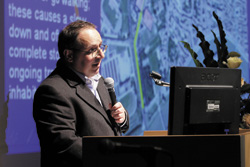 |
|
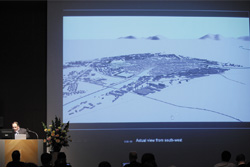 |
 Assistant Prof. Paolo Fiamma, Civil Engineering Department, University
of Pisa Assistant Prof. Paolo Fiamma, Civil Engineering Department, University
of Pisa |
Prof. Wael Abdelhameed, Assistant Professor, College of Engineering, University
of Bahrain, Bahrain / Faculty of fine Arts at Luxor, South Valley University,
Egypt made a presentation on behalf of the group for the group project
"VR Model Creation of Insulation Material and Insulation Effect in
British Houses". When many of buildings of historical value in U.K.
are required to renovate for improving energy efficiency, they are trying
scientific and holistic approach through creating VR with UC-win/Road as
well as microsimulation of construction in regard to various restrictions,
as he discussed.
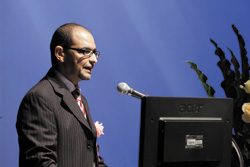 |
|
 |
 Assistant Prof. Wael Abdelhameed, College of Engineering, University of
Bahrain Assistant Prof. Wael Abdelhameed, College of Engineering, University of
Bahrain |
Prof. Claudio Labarca Montoya, Associate Professor, Faculty of Architecture,
Design and Urban Studies, Pontifical Catholic University of Chile presented
a project he is currently working on for a TV program of weather forecasting
under the title of "City Modeling and VR Walk-throughs". This
is a kind of advertisement, representing popular cities among tourists
in all parts of the country in 3D models and providing them on real time
basis. He explained a series of working process and the program structure
in concrete with demonstration. He mentioned that he was using UC-win/Road
for creating base models and such, and also hoping to explore possibility
of utilizing it more continuously.
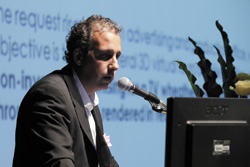 |
|
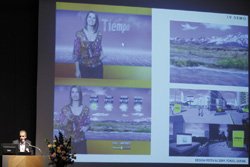 |
 Associate Prof. Claudio Labarca Montoya, Faculty of Architecture, Design
and Urban Studies, Pontifical Catholic University of Chile Associate Prof. Claudio Labarca Montoya, Faculty of Architecture, Design
and Urban Studies, Pontifical Catholic University of Chile |
Prof. Marcos Novak, Professor, Media Arts & Technology Graduate Program,
University of California, Santa Barbara presented under the title of "Cities
of Bridges". He first stated that he was just starting to learn about
UC-win/Road, expecting towards the potentials of its diversified functions.
He showed some examples including his attempt to create traffic pattern
on his own, and proposed an approach of using UC-win/Road as a design tool.
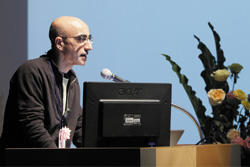 |
|
 |
 Prof. Marcos Novak, Media Arts & Technology Graduate Program, University
of California, Santa Barbara Prof. Marcos Novak, Media Arts & Technology Graduate Program, University
of California, Santa Barbara |
Dr. Yoshihiro Kobayashi, World 16 Chair, made its last presentation. First,
he reviewed the vision of "World 16" project and its activities
over a year, and showed his view that this project has led steadily to
highly qualified result of the research. He further mentioned the project's
new direction of development based on the emerging issues out of the results.
Then he talked about his own study under the title of "Development
of Data Exchange Tool of VR Modeling", explaining the functions and
mechanics of the plug-ins for 3DSMax that was developed this time, as well
as its operation procedure and application examples.
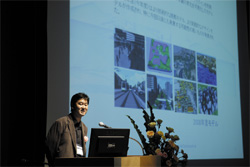 |
 Dr. Yoshihiro Kobayashi, World 16 Chair Dr. Yoshihiro Kobayashi, World 16 Chair |
After that, Dr. Brendan Hafferty, General Manager, FORUM8 Europe made the
closing presentation of this symposium, speaking about marketing of 3D-VR.
He showed the way of future marketing and how to look at the matter to
be found there.
When all the lectures were over, Academy Encouragement Prizes were granted
to Prof. Tomohiro Fukuda, Prof. Michael Jemtrud, Mr. Matthew Swarts (as
a group project), and Mr. Taro Narahara for the research findings of "World
16".
Moreover, after the symposium was over, a networking party was held partly
to celebrate the publication of a book "STRUCTURAL ANALYSIS - Case
Studies and Numerical Simulation -", having a lot of attendants. We
would like to express our hearty thanks again to have an invaluable opportunity. |
|
|
| [Day3] 8th 3D VR Simulation Contest |
Diversification and Advancement of VR Application
FORUM8 held the 8th 3D VR Simulation Contest in November 20, 2009, the
last day of FORUM8 Design Festival 2009-3 Days, at the main hall of Tokyo
Conference Center Shinagawa.
Established after UC-win/Road won "Software Products of the Year"
Award in 2002, this contest actually shows the potential of UC-win/Road
for application every time. This 8th contest also provided competition
of advanced technologies as well as unique ideas through varied application
cases.
Specifically this time, the contest was held between the release dates
of the latest strategic VR product "VR-Studio" (October 26) and
the latest version of 3D real-time VR "UC-win/Road Ver.4" (December
9). Consequently, the latest information on each product was also presented.
It is expected to have the contest on a more advanced stage with these
products from the next time. |
|
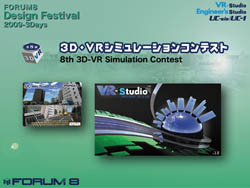 |
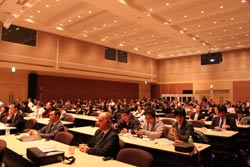 |
|
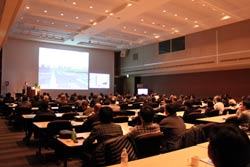 |
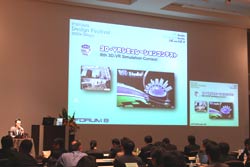 |
|
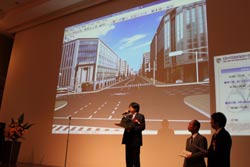 |
 Tokyo Conference Center Shinagawa November 20th, 2009 Tokyo Conference Center Shinagawa November 20th, 2009 |
In this contest, we commissioned Mr. Hiroo Kasagi, Workshop for Sustainable
Community; Mr. Fumio Seki, Taisei Corporation; and Mr. Shinsuke Kitagawa,
Yachiyo Engineering Co., Ltd. to be judges. Prior to the final selection,
a qualifying competition was held with these three judge members. Among
many entries, the top 11 works were nominated including 5 domestic works
and 6 from overseas.
On the day of the contest, each presenter of the nominated work made a
presentation for 15 minutes. Based on the presentation, the contest participants
and judges voted to decide prize winners for each prize. In announcing
the result of the final selection, Mr. Seki made a comment on behalf of
the judges. According to him, usages of UC-win/Road has advanced and diversified.
He pays a special attention to the approaches to the influences that the
user's point of view and roads have on the society.
The prize winners and their works of the 8th 3D VR Simulation Contest are
as follows:
 Results Announcement Results Announcement
 |
"VR Data for Ohashi Junction of Metropolitan Expressway"
Metropolitan Expressway Company Limited |
|
|
| The Metropolitan Expressway Co., Ltd. is performing an experiment with
a driving simulator (UC-win/Road Drive Simulator) to verify effectiveness
of cruise-assist and traffic safety measures at Ohashi Junction, which
connects Central Circular Shinjuku Route (under construction), Central
Circular Shinagawa Route, and Route 3 (Shibuya Line). |
 |
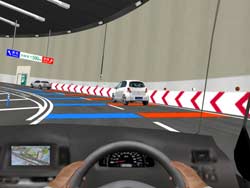 |
 |
 VR Data of Ohashi Junction used for traffic safety and effectiveness VR Data of Ohashi Junction used for traffic safety and effectiveness |
 Overcrossing 4 rods in limited space Overcrossing 4 rods in limited space |
 |
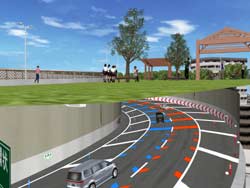 |
 Ensuring the effectiveness in traffic safety at Ohashi Junction, Ensuring the effectiveness in traffic safety at Ohashi Junction, |
 Double loop line to connect roads with 70m height difference Double loop line to connect roads with 70m height difference |
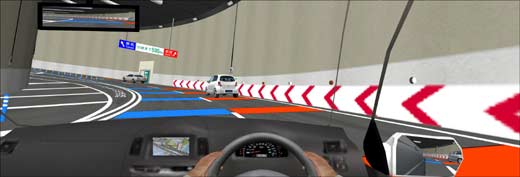 |
 Rooftop of the junction is going to be used as a planted park Rooftop of the junction is going to be used as a planted park |
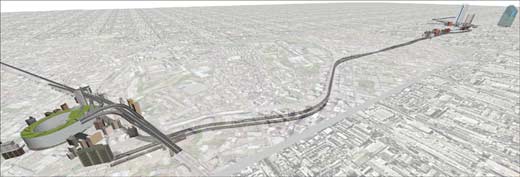 |
 Planned as the second longest tunnel in the world Planned as the second longest tunnel in the world |
 |
 Tunnel between Shinjuku Central Circular Route and Shinagawa Central Circular
Route Tunnel between Shinjuku Central Circular Route and Shinagawa Central Circular
Route |
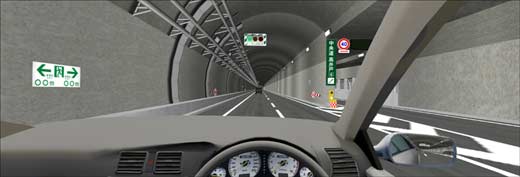 |
 Examining the best position for the road signs Examining the best position for the road signs |
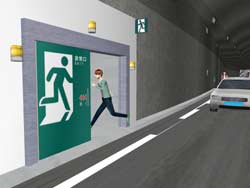 |
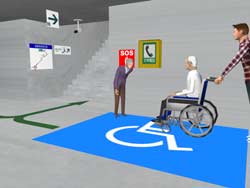 |
 Will be used to explain and display the evacuation route Will be used to explain and display the evacuation route |
 Examining the optimization of evacuation guiding signs Examining the optimization of evacuation guiding signs |
|
|
|
"VR simulation of Design Change of Korea Namhae Highway "
Korea Road Agency (Korea) |
|
|
| UC-win/Road was used as a means of consensus building with the local residents
at Korea Namhae Highway, which is under construction. The original design
was changed in midstream, invoking objections from the local residents.
In response to them, the influences of the highway on the residents were
simulated in various ways. The simulation was effectively used for explanation
to the public, public relations about the project, and materials for consulting
with related agencies. |
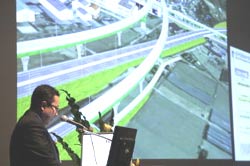 |
 |
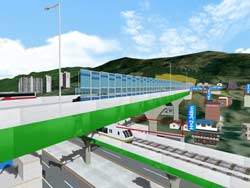 |
 DAEDONG JCT DAEDONG JCT |
 Revised plan due to LRT construction plan Revised plan due to LRT construction plan |
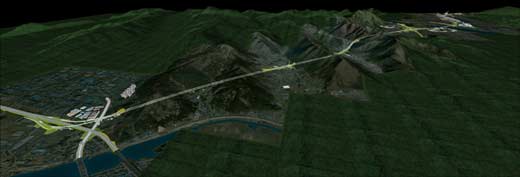 |
 Namhae Highway between Naengjeong and Pusan Namhae Highway between Naengjeong and Pusan |
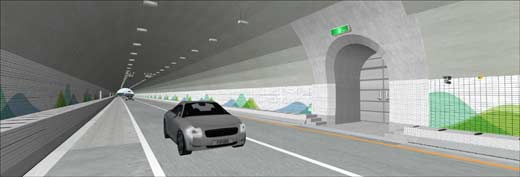 |
 Tunnel used for evacuation Tunnel used for evacuation |
 |
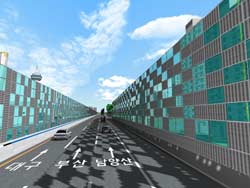 |
 Aiming to ease the traffic congestion Aiming to ease the traffic congestion |
 Noise barrier (over 10m high) Noise barrier (over 10m high) |
 |
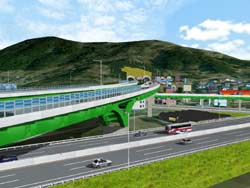 |
 Canal from freight yard to sewage (treatment) plant Canal from freight yard to sewage (treatment) plant |
 The data was used effectively as discussion material for the consensus
with residents and related agencies. The data was used effectively as discussion material for the consensus
with residents and related agencies. |
|
|
|
"Simulation of Railway Bridge Beam Construction Work"
Noda Engineering Co., Ltd. |
|
|
| This work represents the procedure of overpass reconstruction for doubling
track of a single rail track territory in order to boost the capacity of
the railway. In the case of a railway girder, works must be finished at
midnight between the last train and the first train. In addition, the impact
of works on the road below should be minimized. Reflecting these needs,
the company has planned a speedy and economical construction method and
performs simulation of construction. |
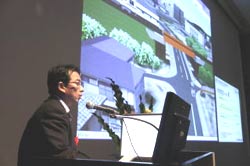 |
 |
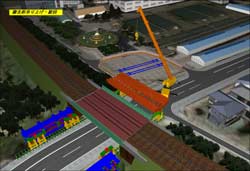 |
 Simulation of Railway Bridge Beam Construction Work Simulation of Railway Bridge Beam Construction Work |
 Removed beam is hanged by crane and crane rotates Removed beam is hanged by crane and crane rotates |
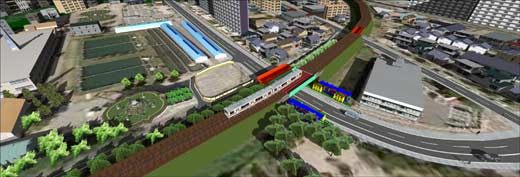 |
 Modeled surroundings including temporary stockyard Modeled surroundings including temporary stockyard |
 |
 |
 Old beam is removed by sliding jack Old beam is removed by sliding jack |
 The installation work must be finished at midnight The installation work must be finished at midnight |
|
|
|
"Simulation of Traffic in Kyoto City"
Graduate School of Informatics Kyoto University |
|
|
| Aiming to collect driving data for building a calculation model that represents
human driving behavior, the driving environment in the urban area in Kyoto
city is build up on UC-win/Road Drive Simulator. In order to acquire realistic
driving data, it was designated to build environment of which quality is
high enough to give a feeling of driving in the urban area of Kyoto. Using
this environment, they are planning to perform an experiment with subjects
to collect large amount of data. |
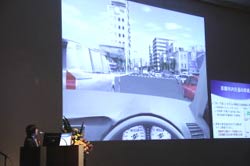 |
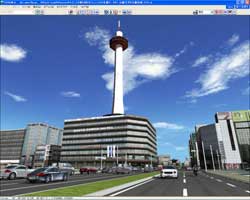 |
 |
 Simulation of Traffic in Kyoto City Simulation of Traffic in Kyoto City |
 Reproduces the traffic condition in Shijo Kawaramachi, the busiest area Reproduces the traffic condition in Shijo Kawaramachi, the busiest area |
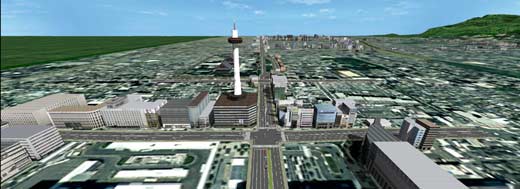 |
 Aim is to collect data to build human driving behavior model Aim is to collect data to build human driving behavior model |
 |
 Modeling of the route from the Kyoto Station to Kyoto University Modeling of the route from the Kyoto Station to Kyoto University |
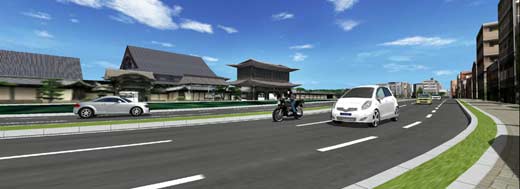 |
 Modeling of traditional buildings and streets of Kyoto Modeling of traditional buildings and streets of Kyoto |
|
|
|
"VR Data of Roundabouts in US 41 Project"
Ourston Roundabout Engineering, Inc.(USA) |
|
|
| The Wisconsin Department of Transportation (WisDOT) plans to reconstruct
and expand US 41. This work is made for a driving simulator that helps
WisDOT to learn about roundabouts in detail and also supports public people
in understanding how to drive in roundabouts correctly. |
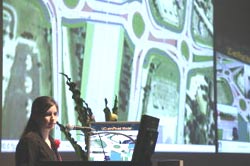 |
 |
 |
 VR Data of Roundabouts in US 41 Project VR Data of Roundabouts in US 41 Project |
 This work was made to educate people on the correct way to negotiate roundabouts. This work was made to educate people on the correct way to negotiate roundabouts. |
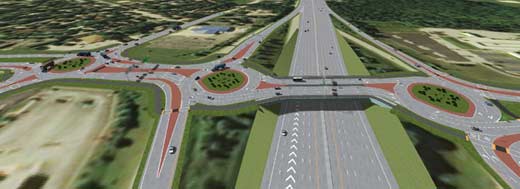 |
 Appearance of the 3 adjacent roundabouts Appearance of the 3 adjacent roundabouts |
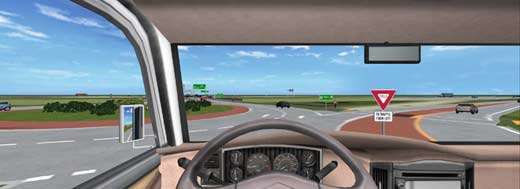 |
 The Wisconsin Department of Transportation plans to construct 44 roundabouts
in US41. The Wisconsin Department of Transportation plans to construct 44 roundabouts
in US41. |
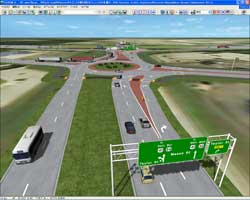 |
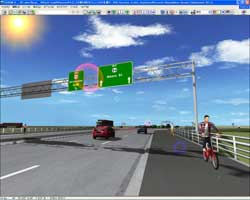 |
 Roundabouts produce efficient traffic flow. Roundabouts produce efficient traffic flow. |
 The important thing is to educate the drivers. The important thing is to educate the drivers. |
|
|
|
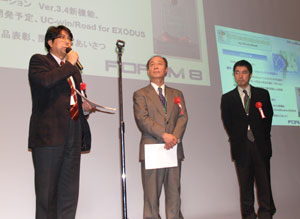 
Judges
Mr. Hiroo Kasagi, NPO Chiiki Zukuri Kobou
Mr. Fumio Seki, Taisei Engineering Co., Ltd.
Mr. Sinsuke Kitagawa, Yachiyo Engineering Co., Ltd. |
|
 |
Regional Construction Award
Mr. Hiroo Kasagi, NPO Chiiki Zukuri Kobou |
"Proposal of Reproducing Environmentally-friendly Waterland City Hino"
Hosei University |
|
|
| Hino City used to be one of the largest granaries in Tokyo. Irrigation
channel networks developed along the Tama River and the Asakawa River.
The city, on the other hand, has promoted land readjustment projects since
1960's in response to a rapid increase in population in the suburban areas
of the metropolitan region. Currently, while 50% of the city area is occupied
by land readjustment area, irrigation networks have been integrated and
many of the tributaries have been abolished. As a result, although the
city was designated as "Water Town" by National Land Agency in
1995, actually both rural landscape and irrigation networks have decreased.
In this context, they propose a land readjustment concept that is environmentally
sound utilizing irrigation networks and waterside spaces. |
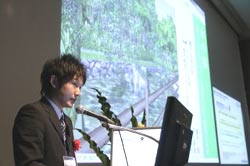 |
 |
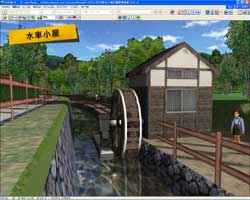 |
 Environmentally-friendly land readjustment plan of Waterland City Hino Environmentally-friendly land readjustment plan of Waterland City Hino |
 Electric power generation by the use of small water channel Electric power generation by the use of small water channel |
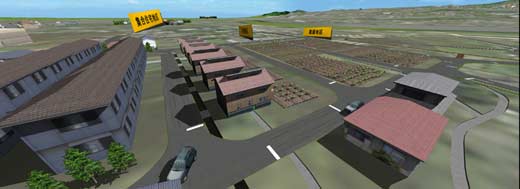 |
 Apartment area, separate house area and plantation area Apartment area, separate house area and plantation area |
 |
 Small scale part-time farmers to produce foods for local consumers Small scale part-time farmers to produce foods for local consumers |
|
|
|
 |
Design Award
Mr. Fumio Seki, Taisei Engineering Co., Ltd |
"VR Project of Beijing Guomian Group (Jingmian Second Factory)''
Beijing Water Cube Digital Technology Co.,Ltd. (China) |
|
|
| Located to the east of Beijing CBD, Guomian Group is overlooking from its
main gate the landmark buildings in Beijing, including CCTV, China International
Trade Center, and Huamao. Designed by a designer in the former Soviet Union
and constructed in 1950's, its interior decoration reflects the style of
the past time. Using UC-win/Road, the work represents in VR the old plant
of the Guomian second plant and the new plant, which was relocated and
changed into Cultural and Creative Industrial Park in recent years. |
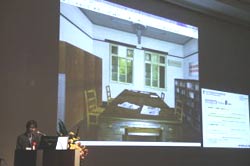 |
 |
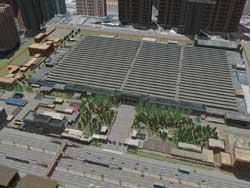 |
 Beijing Guomian Group Jingmian 2nd Factory- office room and an old made-in-
China fan Beijing Guomian Group Jingmian 2nd Factory- office room and an old made-in-
China fan |
 Appearance of Jingmian second plant Appearance of Jingmian second plant |
 |
 Building front and its surroundings- the plant will change to Cultural
and Creative Industrial Park. Building front and its surroundings- the plant will change to Cultural
and Creative Industrial Park. |
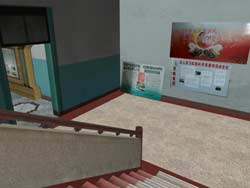 |
 |
 Try to record the old plant by VR as a conserving material Try to record the old plant by VR as a conserving material |
 Arbors for the rest can also be seen by VR Arbors for the rest can also be seen by VR |
|
|
|
 |
Artistic Award
Mr. Sinsuke Kitagawa, Yachiyo Engineering Co., Ltd. |
"Creation of Road Which Is Suitable for Aso Kuju National Park"
Nishitetsu C.E.Consultant Co.,Ltd |
|
|
| This VR data shows planned four-lane road of the national highway that
passes through Aso-Kuju National Park (Scenic Byways). As this route not
only passes through steep landforms but also have large structures alongside
accompanied by the railway running in parallel with it, it was required
to take into consideration not only driving simulation (internal environment)
but also external environment. Thus, using VR data, they propose to examine
landscape as well as to mitigate congestion. |
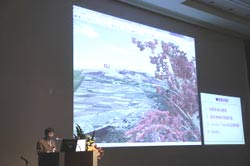 |
 |
 |
 1-Aiming to create a road which is suitable for the Aso Kuju National Park 1-Aiming to create a road which is suitable for the Aso Kuju National Park |
 Planned model of 4-lane "Scenic Byway" Planned model of 4-lane "Scenic Byway" |
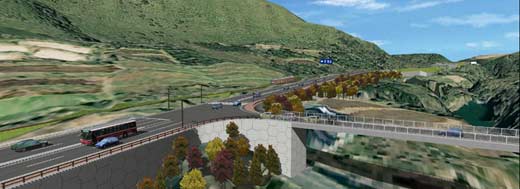 |
 Aiming to ease traffic congestion and preserve natural landscape Aiming to ease traffic congestion and preserve natural landscape |
 |
 Modeling of Aso Kuju National Park and surrounding landscape Modeling of Aso Kuju National Park and surrounding landscape |
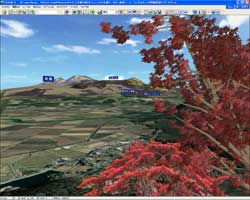 |
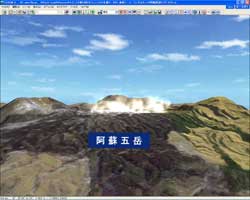 |
 Expression of the coloured leaves in autumn Expression of the coloured leaves in autumn |
 Five mountains (Aso Gotake) which makes Mt. Aso Five mountains (Aso Gotake) which makes Mt. Aso |
|
|
|
"Road Monitoring System"
Temasek Polytechnic (Singapore) |
|
|
| The road monitoring system is a system that acts as a virtual driving simulator
to assist drivers in rehabilitation and assessment. Therefore the simulator
will be able to test the users physical condition and problem solving skills
in order to rate their condition. |
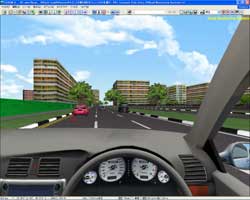 |
 |
 Road monitoring system Road monitoring system |
 Training simulator for physical rehabilitation for stroke patients Training simulator for physical rehabilitation for stroke patients |
 |
 |
 Signal settings and avoiding obstacles Signal settings and avoiding obstacles |
 Physical balance check for the drivers Physical balance check for the drivers |
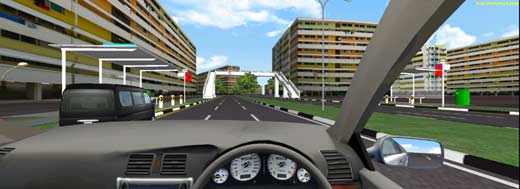 |
 Proposal of a rehabilitation supporting system Proposal of a rehabilitation supporting system |
|
|
|
"Transfer VR simulation at Junjon Service Area in Korea"
GTSM Inc. (Korea) |
|
|
| VR simulation by using UC-win/Road was conducted for Junjon Service Area,
which is managed by Seoul Regional Land Management Office. To ease traffic
jams on the roads to the neighbouring cities, the simulation by UC-win/Road
was used to support decision making of 3 plans including creation of bus-lane
and rotary intersection. |
 |
 |
 VR simulation for transfer at Junjon Service Area VR simulation for transfer at Junjon Service Area |
 Plan to construct a bridge at the intersection Plan to construct a bridge at the intersection |
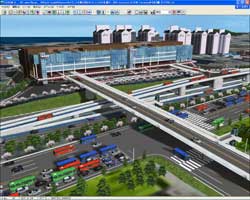 |
 |
 The 2nd plan: Highway bus lane separated from city bus lane The 2nd plan: Highway bus lane separated from city bus lane |
 The 3rd plan: Making rotary The 3rd plan: Making rotary |
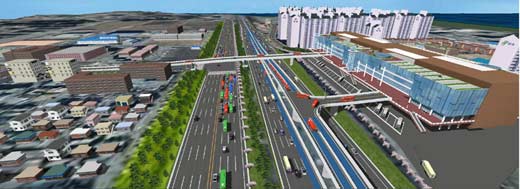 |
 VR accelerated the decision making of the project VR accelerated the decision making of the project |
|
|
|
"VR Simulation of Pedestrian Behavior at Pedestrian Bridge Construction"
Shanghai Chikushi Construction Design Co., Ltd. (China) |
|
|
| VR model shows the pedestrian behavior and flow at the time of renovation
and construction of a pedestrian bridge in the United Kingdom (about 150m).
Results of the data from the crowd analysis software have been linked to
UC-win/Road, and the intuitive presentation has become possible. The data
was used for reproducing the planned completed construction and for further
safety as well as simulating the pedestrian flow. |
 |
|
 |
 VR Simulation of Pedestrian Behavior VR Simulation of Pedestrian Behavior |
|
 Results of the data from the crowd analysis software have been linked to
Micro Simulation Player Results of the data from the crowd analysis software have been linked to
Micro Simulation Player |
 |
|
 |
 Result of the regulated Pedestrian flow Result of the regulated Pedestrian flow |
|
 Pedestrian flow on the shopping streets Pedestrian flow on the shopping streets |
|
|
|
|
|
|